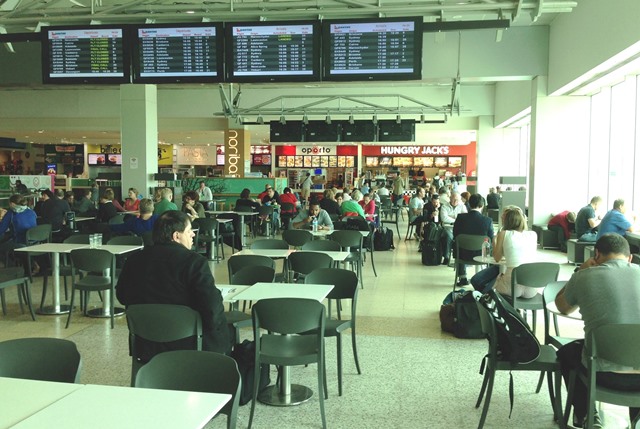- Home
- Blog
- Healthy Weight Loss
- Keep off the kilos when you travel
Keep off the kilos when you travel
Written by Catherine Saxelby
on Monday, 04 November 2013.
Tagged: healthy eating, travel, weight loss

In the October edition of our Foodwatch newsletter we looked at the fraught issue of weight management and travel. The topic was so popular and we had such lovely feedback that we thought those of you who don’t subscribe to the Foodwatch newsletter might also be interested to read about it. That’s why we’ve created this post detailing the most important points.
It’s not just luggage weight you have to watch when you travel
Taking off for another country or another location is exciting but finding healthy food in places like airports, theme parks and restaurants can prove difficult. What’s more all that waiting around that modern travel involves just invites us to eat out of boredom.
Airports – a trap for the bored and unwary
Airports are designed as retail therapy for the bored traveller waiting to take-off. They are crammed with cafes, fast food outlets, bars, restaurants and sandwich shops as well as any number of shops, newsagents, gift shops and duty-free outlets trying to sell us perfumes, makeup, chocolates, local food delicacies and alcohol at what “looks like” bargain prices.
If you’re stuck in an airport, you’re a prime candidate for comfort eating. You’re bored, you have nowhere else to go and you’re looking for some way to whittle down the hours of waiting before your flight leaves. The only options are eat, read, sleep, shop. It’s hard to sleep and still keep an eye on your belongings and reading’s almost impossible with all those announcements etc., so that only leaves eating and shopping and that’s what most of us do.
The retailers know we’re bored and will probably order something we don’t need just to pass the time before our flights depart – a cappuccino, a muffin or a cookie perhaps? Maybe you have local change you need to use up? A bar of chocolate or a drink at the bar?
5 tips to avoid the airport trap
What can you do? The first thing is to be aware of the problem and then takes steps to minimise the effects. Here are five tips:
- Choose healthier food options if they are available – salad, a piece of fruit, a low-fat latte.
- Drink lots of water – flights are very dehydrating and this will help and it will curb any hunger feelings you may have as you survey all the tempting things on offer.
- Walk around. Don’t just sit in the lounge area. Walking is useful exercise and airports these days are large and give plenty of scope for the odd 20 minute walk.
- Indulge your fantasies for luxury shopping by trying out all the expensive things you know you won’t buy because you don’t need/can’t afford them. It can be fun and it takes time.
- Use your local change to buy paperbacks to read on the journey instead of chocolate and sweets or donate it to UNICEF via their in-flight envelopes.
Airline food – why is it so unenjoyable?
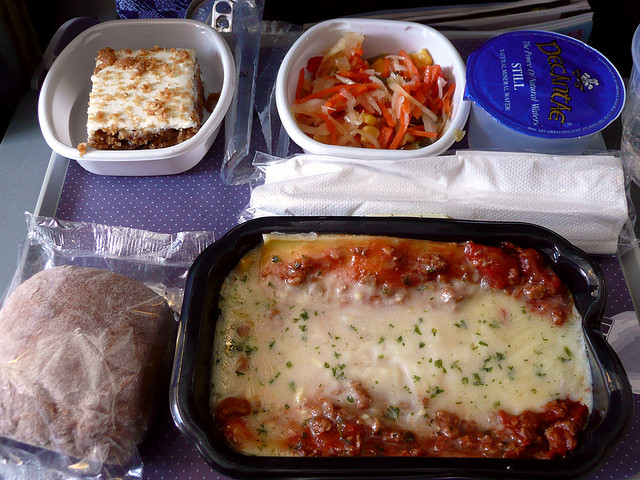 Having survived the airport you’re now confronted with those pre-cooked airline meals. They’re doled out at regular intervals whether you’re hungry or not and they aren’t the most fresh, tasty or nutritious.
Having survived the airport you’re now confronted with those pre-cooked airline meals. They’re doled out at regular intervals whether you’re hungry or not and they aren’t the most fresh, tasty or nutritious.
They have to be cooked on the ground, chilled in a blast freezer and then reheated in hot air convection ovens. That’s not a good start to any meal. However, food treatment is only half the story of why airline food is so “blah”.
The air in modern airliners has reduced humidity and this dries out the mucous membranes in our noses which makes it difficult for us to smell. As smelling food is a major factor in tasting food this means we’re behind the eight ball straight away.
What’s more, studies have shown that our tastebuds are up to 30 percent less efficient at high altitudes so this affects our perception of the tastiness of the food on offer.
In the air, energy in almost always outweighs energy out
From a weight perspective remember the energy in/energy out equation. If you’re taking in high energy foods like ice cream, chocolate, rice, bread and alcohol then your energy intake is bound to exceed your energy use.
Don’t forget we’re pretty much sedentary for the whole of that flight. Especially on long flights like those from Europe or the US to Australia where we’re basically sitting or reclining for anywhere from 14 to 24 hours. Short walks around the cabin to minimise the likelihood of DVT (Deep Vein Thrombosis) and the odd visit to the aircraft toilets are pretty much the only exercise you can get.
Eat what you know when travelling. Does it work?
If you’ve been on a regular healthy eating plan and there are products that you know work for you, say for breakfast, then it can be tempting to try to replicate this, especially if you’re staying with friends or family and you can visit a supermarket. After all Special K is Special K isn’t it? It would appear not.
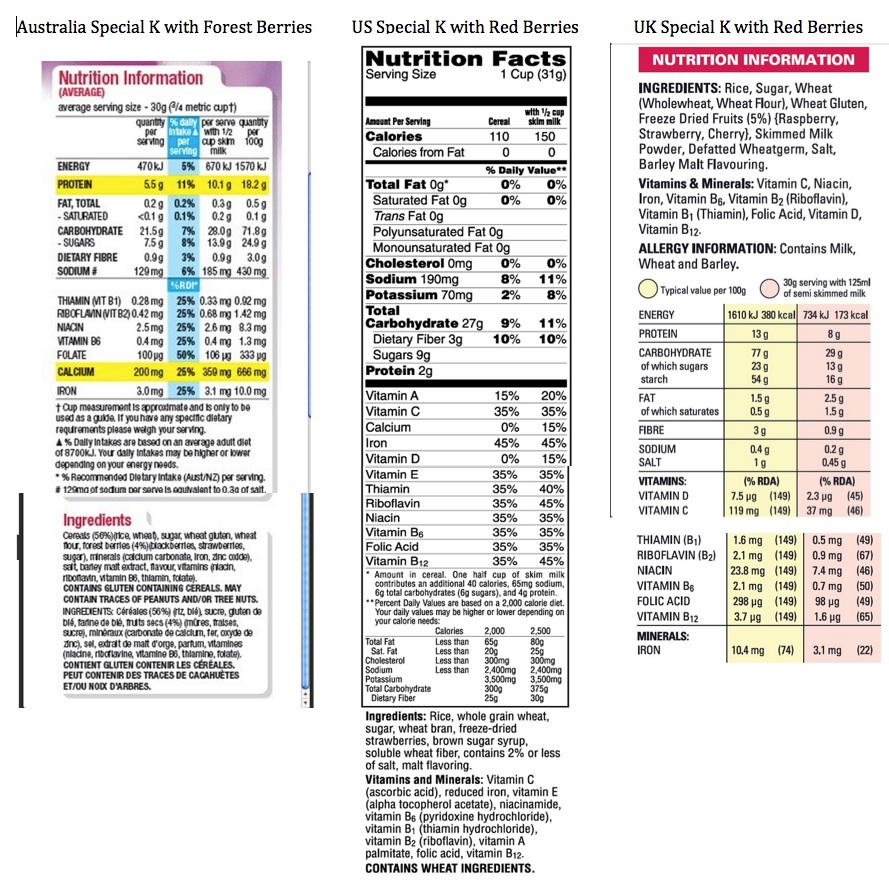
My colleague Munaiba Khan recently visited the UK and USA. She couldn’t find her regular Uncle Toby’s Plus cereal in the UK and opted for what looked similar – Special K with red berries. In the USA she also saw Special K with red berries but it tasted different, much sweeter. On her return she decided to check the ingredients of the UK, US and Australian packets to see if her suspicions were correct. The pack information isn’t immediately comparable but she’s done the conversions for you and here’s what she found:
|
Amount per serving ( ~ 30g) |
US |
UK |
Australia |
| Sugar | 9 g | 6.9 g | 7.5 g |
| Salt | 0.48 g | 0.3 g | 0.3 g |
| Fibre | 3 g | 0.9 g | 0.9 g |
As you can see the US cereal is much sweeter than the other two, has 50% more salt than the other two but almost three times the fibre. The moral for the weight-conscious traveller is clear – read the pack! Your familiar foods may not be formulated the same in different countries.
Once you’ve arrived at your destination then what?
It can be hard to eat healthily when you’re travelling. Often you are on holiday and feel you deserve a treat or two and so you relax your guard. Then there are the unfamiliar foods that may taste great but you have no idea how healthy they are. Do they have too much sugar, fat, salt – who knows?
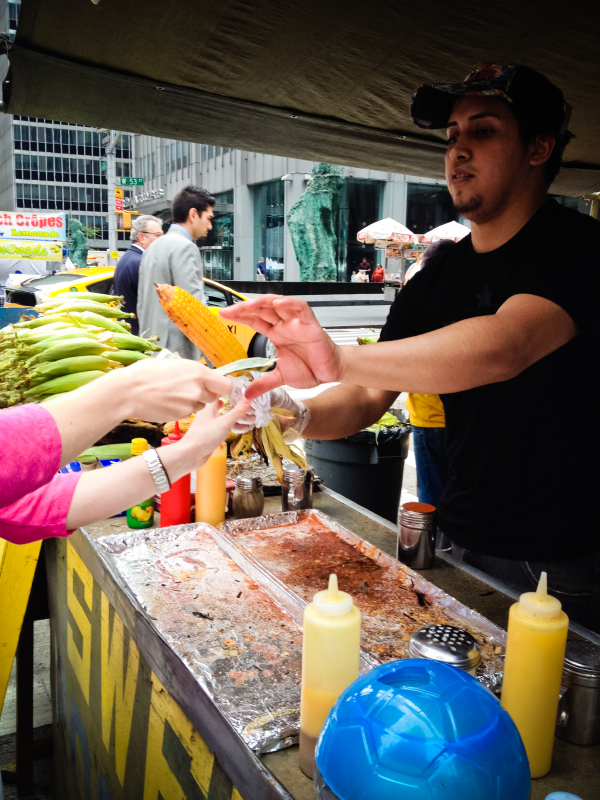 We all like to try local specialities, after all that’s part of the joy of travel, immersing yourself in another culture, even another Western culture like the US or Europe but it can definitely have consequences for your waistline. For example, items like “hush puppies”. This is a favourite in the southern states of the US and is served up with just about any seafood but it’s really just cornmeal, eggs, salt and buttermilk mixed into a stiff batter and deep-fried. Not a lot to recommend it on the healthy food/calorie control barometer.
We all like to try local specialities, after all that’s part of the joy of travel, immersing yourself in another culture, even another Western culture like the US or Europe but it can definitely have consequences for your waistline. For example, items like “hush puppies”. This is a favourite in the southern states of the US and is served up with just about any seafood but it’s really just cornmeal, eggs, salt and buttermilk mixed into a stiff batter and deep-fried. Not a lot to recommend it on the healthy food/calorie control barometer.
Aside of the odd special restaurant dinner (read my article Eating out 8 lighter options), if you have to eat outside meals look for outlets that sell healthy sandwiches, salads or veg soups. e.g. Prêt-a-Manger which has outlets in the UK, US, France and Hong Kong. It can be expensive (though there are often budget options) but it’s easy if you don’t speak the language (self-serve) and you can see what you’re getting. The food is freshly made and all excess goes to charities at the end of the day.
Eating-in can be a healthy option but watch out as many US households use processed foods as standard meal components. Melanie Warner, author of Pandora's Lunchbox: How Processed Food Took Over the American Meal says that over 70% of the calories consumed in the US come from processed foods. Stick to fresh, home-cooked food with no tinned or bottled sauces or dressings and you should be right.
How to stay regular when you’re travelling
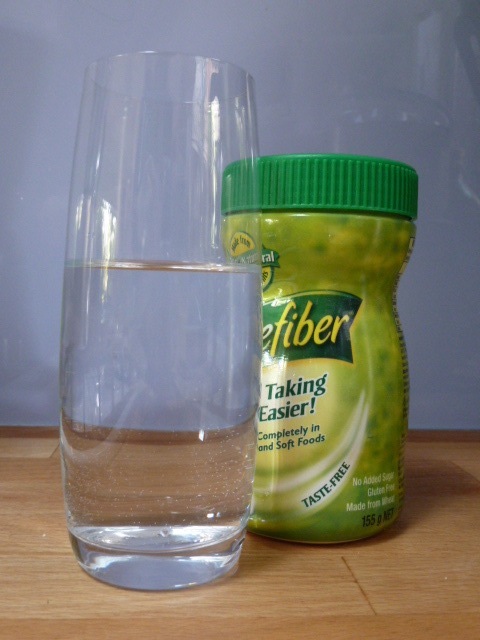
Stay hydrated and make sure you carry your own refillable bottle of water e.g. 250 mL/8 oz that you can top up and that isn’t too heavy in your handbag or back pack.
Tips to avoid getting gastro or food poisoning
One sure way to lose weight on your travels is to get gastro but that’s a weight-fix no one wants! To avoid the local gastro make sure you:
- Wash your hands frequently.
- Use sanitising lotions in a carry pack. They do contain alcohol but they work, though not as well as soap and water.
- Be vigilant in countries known for gastro.
- Whenever you return to the place you’re staying wash your hands thoroughly and always before you touch food.
- Don’t touch your face while you’re out and about unless you have clean hands. You may think this is a strange one but you’d be surprised just how often you touch face during the day without realising it so stay aware – an itchy nose, a stray hair tickling your face and the usual habits we have such as stroking our chins etc., can lead to you transferring nasties to your mouth and nose.
Enjoy your travel and we hope these pointers prove useful.
You may also be interested in...
Foodwatch
The Good Stuff
The Boring Stuff
© 2025 Foodwatch Australia. All rights reserved
Website by Joomstore eCommerce
